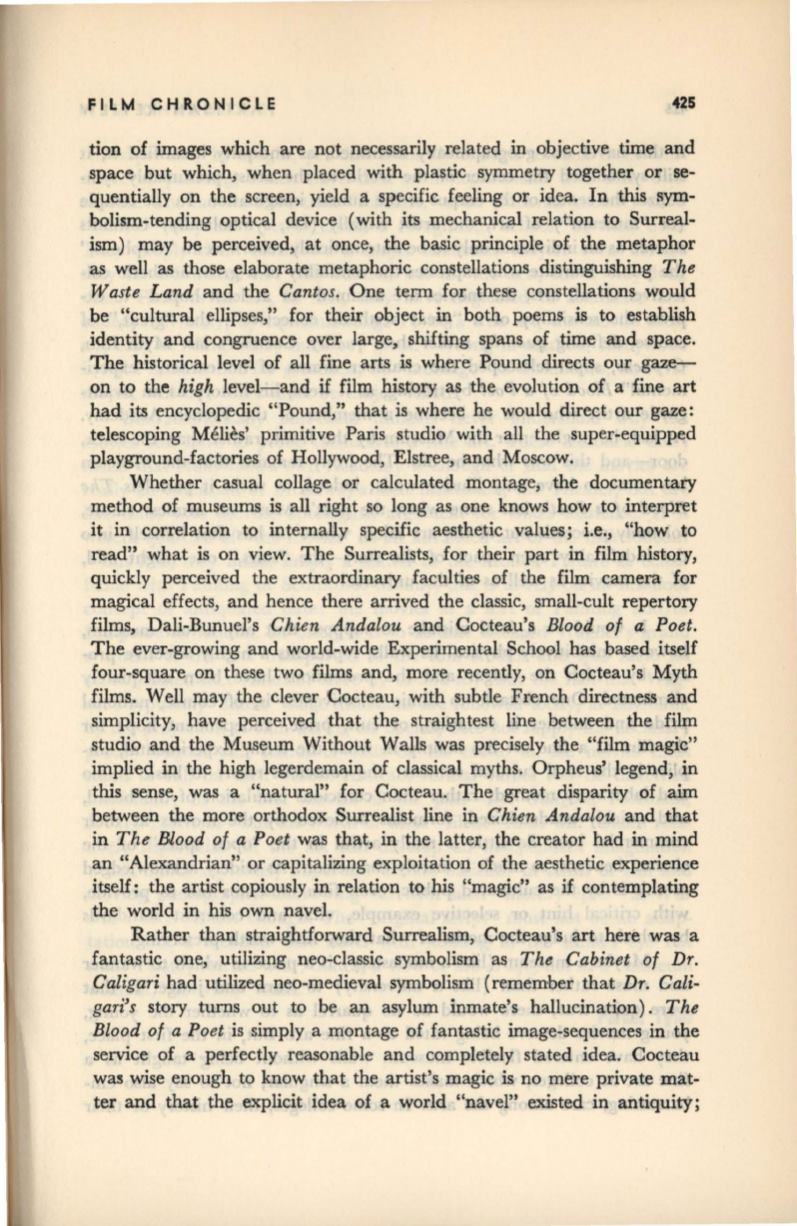
FILM CHRONICLE
425
tion of images which are not necessarily related in objective time and
space but which, when placed with plastic symmetry together or se–
quentially on the screen, yield a specific feeling or idea.
In
this
sym–
bolism-tending optical device (with its mechanical relation to Surreal–
ism) may be perceived, at once, the basic principle of the metaphor
as well as those elaborate metaphoric constellations distinguishing
The
Waste Land
and the
Cantos.
One term for these constellations would
be "cultural ellipses," for their object in both poems is to establish
identity and congruence over large, shifting spans of time and space.
The historical level of all fine arts is where Pound directs our gaze-–
on to the
high
level-and if film history as the evolution of a fine art
had its encyclopedic "Pound," that is where he would direct our gaze:
telescoping Melies' primitive Paris studio with all the super-equipped
playground-factories of Hollywood, Elstree, and Moscow.
Whether casual collage or calculated montage, the documentary
method of museums is all right so long as one knows how to interpret
it in correlation to internally specific aesthetic values; i.e., "how to
read" what is on view. The Surrealists, for their part in film history,
quickly perceived the extraordinary faculties of the film camera for
magical effects, and hence there arrived the classic, small-cult repertory
films, Dali-Bunuel's
Chien Andalou
and Cocteau's
Blood of a Poet.
The ever-growing and world-wide Experimental School has based itself
four-square on these two films and, more recently, on Cocteau's Myth
films. Well may the clever Cocteau, with subtle French directness and
simplicity, have perceived that the straightest line between the film
studio and the Museum Without Walls was precisely the "film magic"
implied in the high legerdemain of classical myths. Orpheus' legend, in
this sense, was a "natural" for Cocteau. The great disparity of
aim
between the more orthodox Surrealist line in
Chien Andalou
and that
in
The Blood of a Poet
was that, in the latter, the creator had in mind
an "Alexandrian" or capitalizing exploitation of the aesthetic experience
itself: the artist copiously in relation to his "magic" as if contemplating
the world in his own navel.
Rather than straightforward Surrealism, Cocteau's
art
here was a
fantastic one, utilizing neo-classic symbolism as
The Cabinet of Dr.
Caligari
had utilized neo-medieval symbolism (remember that
Dr. Cali–
gari's
story turns out to be an asylum inmate's hallucination).
The
Blood of a Poet
is simply a montage of fantastic image-sequences in the
service of a perfectly reasonable and completely stated idea. Cocteau
was wise enough to know that the artist's magic is no mere private mat–
ter and that the explicit idea of a world "navel" existed in antiquity;


